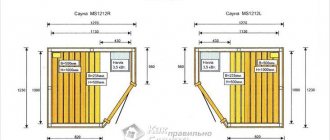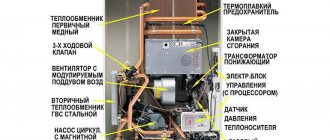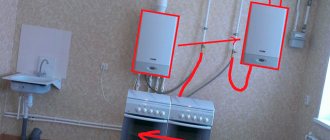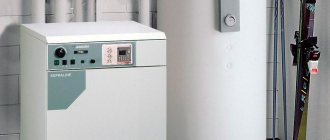Home / Tips
Back
Published: 04/28/2020
Reading time: 3 min
0
4815
It is natural for a person to arrange his home, while he strives to hide all utility networks as much as possible. In connection with this, the question is increasingly being asked on the Internet about whether it is possible to install a boiler in the bathroom.
In fact, this conclusion suggests itself to every developer when determining the option for installing boilers in a small house or apartment.
In practice, everything does not look so simple. The reason for this is the fact that there are still discrepancies on this issue in some state regulations.
In addition, there are established minimum standards for the size of the room, which is the starting point when deciding on installing a boiler in the bathroom.
- 1 Why a boiler in the bathroom
- 2 Rules and regulations 2.1 Reasons for prohibiting installation in the bathroom and toilet
- 2.2 Is it possible to bypass the ban?
- 2.3 What is provided for unauthorized installation
Installation: recommendations and diagrams, main stages of chimney installation
Chimney installation is divided into several stages - preparatory work, installation itself, then connection, startup and, if necessary, debugging of the entire system.
General requirements
When several heat-generating installations are combined, each of them creates its own chimney. In exceptional cases, a tie-in to a common chimney well is allowed, but a difference in height of at least one meter must be maintained.
First, the chimney parameters are designed and calculated, which are based on the recommendations of gas boiler manufacturers.
When summing up the calculated result, the internal cross-section of the pipe cannot be less than the diameter of the boiler outlet pipe. And according to testing according to NPB-98 (fire safety standards), the initial speed of the natural gas flow should be 6-10 m/sec. And besides, the cross-section of such a channel must correspond to the overall performance of the unit (8 cm2 per 1 kW of power).
Installation steps
Chimneys for gas boilers are mounted outside (attached system) and inside the building. The simplest is the installation of the outer pipe.
Installation of an external chimneySource astroyresurs.ru
Installing a chimney on a wall-mounted boiler is done as follows:
- A hole is cut in the wall. Then a piece of pipe is inserted into it.
- The vertical riser is assembled.
- The joints are sealed with a fireproof mixture.
- Fixed with wall brackets.
- An umbrella protecting from precipitation is fixed on top.
- An anti-corrosion coating is applied if the pipe is made of metal.
Proper installation of the chimney guarantees its impermeability, good draft, and does not allow soot to accumulate. Installation performed by specialists will significantly reduce the cost of maintaining this system.
When constructing an opening for a pipe in the roof of a house, special boxes with aprons are used. In this case, the design as a whole is influenced by such factors as:
- The material from which the pipe is made.
- External design of the chimney.
- Type of roof covering.
The main factor influencing the choice of design is the temperature of the gas that passes through the pipe. At the same time, according to standards, the distance between the chimney pipe and combustible materials must be at least 150 mm. The most advanced assembly system is considered to be in segments, where all elements are assembled using the cold forming method.
Pros and cons of installing a gas boiler in the bathroom
Many people are attracted to installing a gas device in the bathroom for the following reasons:
- compact location;
- the unit is not “conspicuous” and does not interfere with movement;
- hot water is immediately supplied to the main water intake points - the sink and shower.
There are also disadvantages to this arrangement:
- high humidity negatively affects the metal parts of the device;
- bathrooms usually have small dimensions, so even a compact wall-mounted unit will take up quite a lot of space;
- there is a high probability that in order to meet all safety requirements, the bathroom will have to be re-equipped.
Think carefully about whether such placement of a gas boiler is suitable in your case. Perhaps the best installation option would be a kitchen or hallway.
Video description
How to install a chimney pipe, see the following video:
Connecting a ceramic chimney
Ceramic chimneys themselves are practically eternal, but since this is a rather fragile material, you need to clearly understand how to correctly connect (docking) the metal part of the chimney and the ceramic one.
Docking can only be done in two ways:
For smoke - a metal pipe is inserted into a ceramic
It is important to remember here that the outer diameter of the metal pipe should be smaller than that of the ceramic one. Since the thermal expansion of metal is much greater than that of ceramics, otherwise the steel pipe, when heated, will simply rupture the ceramic one.
For condensate, a metal pipe is placed over a ceramic pipe.
For both methods, specialists use special adapters, which, on one side, are equipped with a gasket for contact with a metal pipe, and on the other, which contacts directly with the chimney, are wrapped in a ceramic cord.
The joining should be carried out through a single-wall pipe - it has a higher heat transfer coefficient. This means that the smoke will have time to cool down a little by the time it reaches the adapter, which ultimately extends the service life of all materials.
Types of water heating equipment for the bathroom
Today, the range of devices for heating water is very wide and varied. The choice of equipment suitable for household needs depends on how many liters of water per day each family member needs. In addition, when purchasing a water heating device, it is necessary to take into account the following indicators:
- Energy source
- The location where the unit will be installed. For small apartments, it is advisable to choose compact water heating devices.
- Safety.
- Source of energy consumed.
- The amount of gas or electricity consumed.
If a number of problems may arise with the installation of gas-powered units in the bathroom, then the installation of water heating equipment in such parts of the house is permitted. That is why most apartment owners use storage tanks to heat water, which also provide heating for the bathroom.
Currently, the most common water heating devices are:
- Storage units for heating water.
- Instantaneous water heaters.
- Single-circuit and double-circuit boilers.
- Thermostatic mixer-water heater.
Is it possible to install a gas boiler in the bathroom?
I live in the Rostov region. I want to replace the old Don 16 boiler and the old-style water heating column with a wall-mounted Proterm Gepard gas boiler with an internal combustion chamber in the bathroom. Our gas workers prohibit installing a wall-mounted boiler in the bathroom. Do I have any chance to argue with them?
SNiP 2.04.08-87 directly prohibited the installation of gas equipment in the bathroom. By Decree of the State Construction Committee of the Russian Federation dated December 23, 2002 N 163, SNiPs regulating gas distribution systems were declared ineffective on the territory of the Russian Federation from July 1, 2003. Instead, SNiP SNiP 31-02-2001 and 42-01-2002 “Gas distribution systems” were put into effect.
SNiP 31-02-2001 states:
“6.14 In the absence of centralized heat supply, automated heat generators of full factory readiness should be used as sources of thermal energy operating on gas or liquid fuel. These heat generators should be installed in a ventilated area of the house on the first or ground floor, in the basement or on the roof
. Generators with a thermal power of up to 60 kW can be installed in the kitchen.
The room in which the heat generator running on gas or liquid fuel is located must have a window with an area of at least 0.03 m2 per 1 m3 of room.
The gas pipeline should be entered directly into the kitchen or into the room for placing the heat generator. The internal gas pipeline in the house must meet the requirements for low-pressure gas pipelines according to SNiP 2.04.08.”
SNiP 42-01-2002 “Gas distribution systems” does not directly mention the ban, but there is the following clause:
“7.2 Premises of buildings for all purposes (except residential apartments) where gas-using equipment is installed, operating in automatic mode without the constant presence of maintenance personnel, should be equipped with gas monitoring systems with automatic shutdown of the gas supply and output of a signal about gas contamination to a control center or to a room with constant presence of personnel, unless other requirements are regulated by the relevant building codes and regulations.
Coordination of boiler installation
You need to go through several authorities to obtain approval for the installation of a gas-fired boiler. Doing it yourself, without approval, the installation process will be illegal and unsafe, and not only for the home owner, but also for the other residents of the house if the boiler is installed in a high-rise building.
Specifications
To connect a private house or apartment to the gas supply, you will have to obtain technical conditions from the gas supply organization that permit this procedure. To do this, a statement is written to the controlling organization. It must indicate the approximate demand for gas volume per hour. The registration procedure lasts seven to fourteen days. Upon successful completion of this event, a document will be issued - technical conditions for the installation of equipment operating on gas fuel. This is a permit for preparatory construction and installation work.
Project
Having the technical specifications in hand, you can proceed to the second step - developing design documentation. The gas supply project includes plans for laying a gas supply pipe from the boiler installation site to the central gas pipeline.
The project will also indicate sections of the gas pipeline crossing the site
If the home is located in the private sector, and the pipeline must cross the land, then a diagram of the gas pipe on the site is also drawn up, indicating the location of its entry into the wall of the house. The project is developed by engineers licensed for such activities, based on the provisions of the GOS.
Coordination with the gas supply organization
The completed project is submitted for approval to the organization that controls gas supply in the applicant’s area of residence. Project approval takes from seven to one hundred days, depending on the volume and complexity of the document. The following materials regarding the heating device are attached to the project:
- examination of the boiler’s compliance with all requirements necessary to ensure normal operation and safety;
- technical passport of the device;
- certificates of compliance with technical and sanitary-hygienic requirements;
- operating instructions.
All documents specified in the list are prepared by the manufacturer and must necessarily accompany any product of this type.
They are transferred by the seller to the buyer when purchasing the device - special attention should be paid to this
If the project was rejected for the first time, the applicant is given a document indicating the reasons for the refusal and a list detailing all the problems of the project that require correction.
If the project is approved, it is certified by the signature and seal of the responsible person. This document is the final permission to install the heating device.
Is it possible to install a gas boiler in a bathroom in a private house?
Many years ago, strict requirements for the installation and operation of gas-fired heating devices were adopted in our country. It is the set of relevant rules and regulations that limits the use of such equipment. According to them, installing a boiler in a bathroom is not provided. But there are exceptions, so today we will try to figure out whether it is possible to install a gas boiler in a bathroom in a private house or apartment. This issue requires thorough study.
What heating devices cannot be installed in bathrooms?
According to current legislation, types of equipment prohibited for installation in such premises include gas units, that is, boilers, heaters, convectors. That is why, when a person asks a representative of the relevant service whether it is possible to install a gas boiler in the bathroom of a private house, he often receives a negative answer. According to state regulations and standards, devices of this kind are not intended for use in closed premises.
Important! Are you installing an individual heating system? You will find all the necessary information on this issue in our article “How to choose a gas boiler?”
It is also prohibited to use heating devices that run on gas and are equipped with open combustion chambers where forced ventilation is installed. Despite the fact that such devices require good air exchange for proper operation, their installation cannot be combined with similar equipment. Under such conditions, the combustion process is disrupted, combustion products begin to accumulate, and there is a danger of poisoning with harmful substances. Find out how to properly install a chimney.
Is it possible or not to install a boiler in the toilet?
This cannot be done without officially certified permits. But under certain conditions, consumers manage to obtain permission to install gas units. If you also want to find out whether it is possible to install a toilet in the boiler room, or, on the contrary, a gas boiler in the toilet, then consider the following requirements:
- Redevelopment of the premises, making adjustments to technical documents. If the gas service does not allow you to register heating equipment, you can take a risk and try to change the status of the premises itself. For example, turn a bathroom into a change room or storage room, submit a corresponding application to the BTI, thereby easily solving the problem. If you indicate these types of premises in the registration certificate of an apartment or house, then they will not be able to refuse you. But the presence of plumbing can lead to problems, namely a ban on installing the boiler.
Important! If there is only a toilet in the room, then there should be no problems either.
- Connecting a new device. If a heating device is already registered in the room design, then no one can prohibit you from installing a new device. The easiest way to replace the boiler is if you already have permission. Less often, craftsmen give consent to install water heating systems in bathrooms. The main thing is that these are devices equipped with a closed combustion chamber.
Important! Still, before choosing, purchasing and installing, it is better to consult with representatives of the gas service, because all the prohibitions and restrictions exist for a reason, but to ensure safety. Moreover, not only yours, but also everyone around you.
Features of installing gas flow-through heaters
Owners of private houses have a better chance of placing gas heaters or boilers in the toilet or bathroom:
- They first need to complete the official paperwork during the design phase of the project. Installation takes place where permitted.
- Then plumbing fixtures are installed next to the device, and plasterboard partitions are installed around it. This is an ideal option for an impromptu redevelopment.
Important! Residents of the private sector often face problems of power outages. This can lead to breakdowns of the gas boiler and other appliances in the house and household appliances. You can prevent malfunctions by purchasing a voltage stabilizer.
In the future, if the owner of the house wants to sell it, problems may arise. After all, as a rule, an examination is carried out related to the dismantling of walls. Officially, this option for installing gas equipment is provided only in the territory of change houses and storage rooms. If these premises meet the accepted requirements, then water heaters can be safely placed there.
Important! High humidity and serious temperature fluctuations usually lead to failure of gas heating devices. So before you decide to take such a step, weigh all the pros and cons, and soberly assess the financial feasibility of this installation option.
Don’t forget about the aesthetic component, because everyone strives to decorate their home beautifully, comfortably and comfortably. Perhaps, while solving technical issues, you will decide to install such equipment in the kitchen. Our review of kitchen design ideas with a gas boiler will help you think through a truly comfortable layout.
Installation of gas heaters
If we examine in detail the documentation related to the operation of heating systems, we will not be able to find specific prohibitions on the installation of this type of equipment in the section on multi-storey residential buildings. That is, the answer to the question whether it is possible to install a gas boiler in the bathroom of a private house cannot be called unambiguous. Some rules and requirements prohibit this, but at the same time others allow it. Therefore, you will have to take into account a lot of important points and nuances that cannot be ignored.
Important! Installation of closed-type gas equipment is permitted if it is not connected to an individual or central heating system.
It is permissible to install gas equipment in premises of a certain nature:
- It is important that they have a light opening and are provided with an effective ventilation regime.
- The room must be at least 15 square meters, since this parameter is directly related to the comfort and safety of using heaters.
Additional boiler installation conditions
Naturally, it is impossible to place gas appliances in the basements of multi-story buildings. Having received permission to install the boiler, you should further follow the following rules:
- Heat generators and gas heaters can only be mounted on walls made of non-flammable or difficult to flammable materials.
- Installation must be carried out in such a way that there are gaps of at least 3 cm between the wall and the device.
- Walls near heaters can only be finished with fireproof materials.
- The cladding should not extend beyond the device body by less than 10 cm.
- Installation of floor-standing boilers requires additional safety measures.
Important! It is recommended to equip extensions and private houses with devices with a sealed combustion chamber and an automatic security system. This is necessary so that in the event of a sudden power outage, the flow of gas will automatically stop.
Video material
Now you know whether it is possible to install a gas boiler in a bathroom in a private house. But this is not enough - it is important to remember all the rules regarding this process. Unfortunately, it is difficult for city apartment owners to obtain permission for such installation, because in modern houses, bathrooms, as a rule, do not reach the required 15 square meters in area. And it’s rare to find an apartment with a toilet window, and also of the required size.
serviceyard.net
Some nuances of installing flow-through gas heaters in the toilet and bathroom
For owners of private cottages, there is another way to obtain official permission to install a boiler or gas heater in the bathroom. First, official documentation is drawn up when developing the project.
Install gas equipment in the part of the home where it is permitted. Then plumbing fixtures, such as a bathtub, are installed next to the fixture and a plasterboard partition is built around it. Such an improvised redevelopment, of course, cannot be called ideal. Subsequently, if the owner wants to sell the house, a number of problems may arise. Specialists from the Bureau of Technical Inventory will be able to conduct an examination only after dismantling the walls.
Officially, installation of a gas boiler is provided only for technical premises - storage rooms, change houses. If such rooms meet the requirements adopted for them, the installation of gas-fired water heaters is permitted.
Appearance of a floor-standing gas boiler
High levels of humidity in the bathroom and temperature fluctuations often lead to breakdowns of gas heating appliances. Before deciding to install it, it is worth considering all the advantages and disadvantages and assessing the financial feasibility of installing such equipment. Obtaining official permission from the relevant authorities is not easy; this can be done by applying some legal tricks.
How to install a boiler in a bathroom.
Installing a boiler in a bathroom is a rather complex professional procedure that can only be done by qualified specialists in the field of design, installation, installation and maintenance of autonomous home heating . Craftsmen installing a gas boiler and accompanying heating equipment must have SRO approval and confirmed qualifications. Try not to install a gas boiler in the bathroom yourself, as this is illegal and can cause harm not only to your property, but also to the life and health of your household. To install a diesel boiler for heating a home , no special permission is required from government authorities, but in any case, amateur activity is obviously contraindicated here.
We recommend: How to turn on a gas boiler: detailed instructions for starting wall-mounted and floor-standing models of the old and new designs after a long or short break, gas or light outage
Most often, a chimneyless gas boiler is installed in the bathroom, as in a room not suitable for heating equipment. Such boilers are small in size and do not require a source of electrical energy. You can install a chimneyless boiler in any non-residential area of the house, including the bathroom; it is wall-mounted, but remember that such a boiler can only be attached to an external wall.
If the bathroom is large in area and volume and it is possible to install a chimney, then you can install a wall-mounted or floor-mounted gas boiler. Remember that there are a number of SNiP requirements for the size of the room in which the gas boiler is installed, the size of the doorway into it, the presence of ventilation, and much more. These requirements are well known only to qualified specialists who have extensive experience in the installation and installation of gas equipment in a private, country house.
What do you need to know when installing a gas boiler in a bathroom?
When looking for a convenient place to install a gas boiler, owners often stop at the bathroom or toilet. But to what extent is such placement allowed by SNiP rules and fire safety standards? Before installing a gas boiler in the bathroom, you should understand this issue in detail.
You are unlikely to find a clear answer to the question of whether it is possible to install a gas unit in a bathroom in the documentation. According to SNiP standards of 1987, the placement of such equipment in the bathroom is prohibited. However, later, since 2003, the cited SNiP was declared invalid and instead SNiP 42-01-2002 “Gas distribution systems” was put into effect. But it does not clearly indicate whether a gas boiler can be installed in a bathroom. You can only get an affirmative answer by contacting your gas supply company.
Important! Only a device with a closed, hinged combustion chamber can be installed in a bathroom or toilet. As practice shows, most gas workers prohibit the installation of gas equipment in the bathroom. The main reasons for refusal are the following:
The main reasons for refusal are the following:
As practice shows, most gas workers prohibit the installation of gas equipment in the bathroom. The main reasons for refusal are the following:
- requirements of old standards;
- insufficient room size;
- high humidity in the bathroom, which leads to rapid failure of equipment;
- interruption of traction due to mixing of moisture with combustion products.
It’s easier for those who already had a gas boiler in their bathroom or toilet. Then they replace the old unit with a new one without much paperwork.
However, some owners resort to tricks and, in order to obtain permission from the gas service, pass off the future bathroom as a furnace room. And after installing the unit, a shower and sink are also placed there. But such a violation is fraught with negative consequences in the form of fines and disconnection from the gas main. The fact is that gas workers are required to periodically check the gas equipment located in the house, so in a year or two the fraud will still be discovered and you will have to pay dearly for it.
If, despite the refusal, you are ready to continue to seek permission to install the unit in the bathroom, then you can go the following way:
- You need to submit a request to the head of the gas service to connect a heating device in the bathroom. In this case, you should attach a list of regulatory documents that allow you to do this.
- If you are refused, you can file a claim in court, where you can always win the case.
Pros and cons of installing a gas boiler in the bathroom
Many people are attracted to installing a gas device in the bathroom for the following reasons:
- compact location;
- the unit is not “conspicuous” and does not interfere with movement;
- hot water is immediately supplied to the main water intake points - the sink and shower.
There are also disadvantages to this arrangement:
- high humidity negatively affects the metal parts of the device;
- bathrooms usually have small dimensions, so even a compact wall-mounted unit will take up quite a lot of space;
- there is a high probability that in order to meet all safety requirements, the bathroom will have to be re-equipped.
Think carefully about whether such placement of a gas boiler is suitable in your case. Perhaps the best installation option would be a kitchen or hallway.
What requirements must a bathroom meet?
It is important to understand that not every bathroom is suitable for installing a gas boiler. For example, standard bathrooms in ordinary Khrushchev or 9-story buildings built in the 70s and 80s are too small and do not have sufficient ventilation. In order for it to make sense to even consider the possibility of installing a gas boiler in the bathroom, it must meet certain requirements:
In order for it to make sense to even consider the possibility of installing a gas boiler in the bathroom, it must meet certain requirements:
- total area of at least 7.5 m²;
- the presence of a working ventilation system;
- there must be a window with an area of at least 0.25 m²;
- ceiling height not lower than 2 m;
- when the door is closed, there should be a gap of 1-2 cm between it and the floor;
- there should be nothing in front of the unit at a distance of 1 m;
- Bathroom walls must be made of non-combustible materials.
Thus, from the above requirements it is clear that apartment owners in multi-storey buildings are practically deprived of the opportunity to install a gas boiler in the bathroom. The owners of private houses have a better chance, since they can initially build a bathroom that meets all the given standards.
No comments yet
Basic conditions for placing a gas boiler in a private house
So, to understand the problem of whether it is possible to install a gas boiler in a bathroom, you need to compare the provisions of several regulations.
Current building codes do not directly prohibit the installation of such equipment indoors, but at the same time require that the following requirements be met:
- The total area of the room must be at least 9 square meters;
- The room must have natural ventilation;
- The boiler power should be no more than 35 kW;
- There should be no high humidity in the room.
Regarding the total area of the room, you need to remember that for a closed combustion chamber the area allowed is 8 square meters, and for an open burner 9 are required.
For boiler rooms and rooms where heating equipment is located, a ventilation system is required. The only catch is that ventilation must be natural, in which air circulation is carried out continuously, without the participation of special instruments and devices. The bathroom is usually equipped with a good ventilation system, but often this system is enhanced by additional equipment - an exhaust or supply fan. From a hygiene point of view, this is good, but from a gas equipment safety point of view, this will be a violation of the technical operating conditions of gas installations.
For private houses, it is allowed to install a heating boiler with a power of up to 35 kW in the kitchen or other room. More powerful heating systems require placement of devices in separate rooms, and this room must meet the requirements of mini boiler rooms, but not a bathroom.
And of course the issue of humidity. The conditions for laying gas supply pipelines must ensure the integrity of the pipes and protect them from corrosion, which means that in a bathroom, as in a room where there is high humidity, metal pipes will be subject to corrosion. So when planning the placement of equipment, the bathroom option will most likely be rejected.
We recommend: Copper pipe repair
Regulatory framework governing the field
Improper use of gas equipment often leads to negative consequences. Therefore, the state regulated this area to the smallest detail.
And, due to this feature, one, even a voluminous document, will not be able to contain all the necessary information.
All necessary rules for installing gas boilers are set out in the relevant governing documents. But the problem is that there are many of them and it will take a lot of time to get to know them. Therefore, in most cases you have to rely on specialists
As a result, there are really a lot of all kinds of instructions. For example, certain related issues are regulated by:
- SP-401.1325800.2018, which sets out the design rules for all kinds of gas consumption systems in residential buildings;
- SP 62.13330.2011, which indicates what the gas pressure should be, how to properly lay pipes to the boiler, etc.;
- GOSTs with numbers R 52318-2005; R 58121.2-2018; 3262-75. Where it is indicated which pipes and connecting elements can and should be used when installing a gas boiler. In addition, steel and other types of gas pipelines are described. And also their characteristics are indicated;
- GOST 27751-2014; SP 20.13330. These documents set out the requirements for the load on external and internal gas pipelines used to install boilers;
- SP 402.1325800.2018, which sets out the rules for connecting boilers to electrical networks;
- SP 28.13330, and in some cases GOST 9.602-2016, which describes methods for combating corrosion;
- SNiP 21-01-97. This document outlines the safety measures that should be observed when operating buildings, including those heated by gas boilers. Building materials are also divided into flammable and non-combustible. And such information is important when equipping the room in which the boiler will be placed.
In addition, you should familiarize yourself with the rules set out in SP 60.13330.2016 (this document is an updated version of the well-known SNiP 41-01-2003). After all, it is precisely this by-law that states that individual heating sources can be used to heat housing and what they should be.
And this is not all you need to know to guarantee the correct placement of the boiler and further safe operation.
It is mandatory to comply with the current requirements when installing boilers. Because otherwise, the specified unit simply will not be allowed for operation. And for unauthorized connection there are strict sanctions in the form of large fines (from 10 thousand rubles). This is stated in Art. 7.19 of the Administrative Code, as well as in Art. 215.3 of the Criminal Code
And, if, for example, the question arose about why you need to know safety measures or loads on pipes during construction. Then you should remember that the installed boiler will be allowed for operation. And, when the established rules set out in the profile document are not followed, the identified shortcomings will have to be eliminated.
In the case when a purchased gas boiler is being installed in your own wooden house and the requirements for the size of the foundation are not met, which at any point must exceed the dimensions of the boiler by at least 30 cm. Then, instead of enjoying comfort, you will have to dismantle the structure and perform new work.
Is it possible to install a gas boiler in the bathroom?
In the 60s, the Russian Federation adopted requirements for the installation and use of natural gas heating devices. The relevant code of practice restricts the operation of such equipment. As a rule, its installation in the bathroom is not provided. However, sometimes it is still possible to install boilers or water heaters in restrooms. This issue should be thoroughly studied.
From discussions on forums and other information sources, it becomes clear that there are certain restrictions for connecting gas equipment. In this article we will try to find out the details of such official requirements.
What types of heating devices are not suitable for a bathroom?
Types of equipment prohibited for installation in such premises include any gas units: water heaters, boilers, convectors. Therefore, the relevant services will most likely give a negative answer to the question of whether it is possible to install a gas boiler in the bathroom.
According to government standards and regulations, such devices are not intended for indoor use.
It is not permitted to operate water heating devices powered by gas and equipped with open combustion chambers in rooms with forced ventilation. Although heating devices require good air exchange for proper functioning, the installation of supply fans cannot be combined with such equipment. The combustion process is disrupted, combustion products accumulate and there is a risk of poisoning with harmful substances. It is permitted to install such devices only in certain cases.
Gas water heater in the bathroom
As a rule, gas equipment specialists do not even agree to replace old products with newer ones.
Is it possible to install a boiler in a toilet?
You cannot install gas equipment in a toilet without official permits. However, under certain conditions, you can obtain permission to install such units.
Installation of a floor-standing gas boiler
If you are wondering whether it is possible to install a gas boiler in a bathroom or toilet, you need to consider the following requirements:
- Redevelopment of the premises and changes to technical documentation. When the Gas Service does not provide registration of the relevant heating equipment, you can try to change the status of the premises. “Converting” a bathroom into a storage room or change room and submitting an appropriate application to the BTI will immediately help solve the problem. If the technical passport of a house or apartment indicates the appropriate types of premises, there will be no refusal from government agencies. However, the presence of plumbing fixtures may result in a ban on the installation of a heating boiler. If only the toilet has been installed in the room, changing the plan will not cause any difficulties.
- Connection of new gas equipment. Provided that registered heating equipment is mentioned in the design of the premises, there will be no problems with installing a new boiler. It is much easier to replace an old device with a new one if permission for similar devices is already available.
Gas service technicians in some regions of our country may agree to install certain water heating systems in sanitary facilities. These must be special devices with a closed combustion chamber. Before selecting and installing such equipment, you must consult with gas specialists.
How to understand the documentation
The situation with permission to carry out installation is somewhat complicated by confusion in the official documentation. The fact is that the adopted Codes of Norms and Rules do not provide a clear explanation of whether gas boilers are allowed in bathrooms. Many employees of the state gas service refer to regulation 2.04.08 –87. It says about the ban on connecting gas boilers in bathrooms.
However, according to the resolution of the State Construction Committee of the Russian Federation dated December 23, 2002, the above documents and norms are considered invalid.
The new requirements (document 42-01-2002) do not contain clear instructions or a strict ban on the installation of gas equipment. As a result, misunderstandings arise. Some employees of the Gas Service simply refuse to install heating gas structures, without delving into the intricacies of the adopted documents and standards.
The process of installing and connecting a gas boiler
Without paperwork and collecting a large number of various permits, you can only install a new gas boiler or water heater in place of old appliances in the bathroom. In this case, if a place for such equipment is already provided, and, therefore, there is also permission, the employee will agree to make the connection.
Some nuances of installing flow-through gas heaters in the toilet and bathroom
For owners of private cottages, there is another way to obtain official permission to install a boiler or gas heater in the bathroom. First, official documentation is drawn up when developing the project.
Install gas equipment in the part of the home where it is permitted. Then plumbing fixtures, such as a bathtub, are installed next to the fixture and a plasterboard partition is built around it. Such an improvised redevelopment, of course, cannot be called ideal. Subsequently, if the owner wants to sell the house, a number of problems may arise. Specialists from the Bureau of Technical Inventory will be able to conduct an examination only after dismantling the walls.
Officially, installation of a gas boiler is provided only for technical premises - storage rooms, change houses. If such rooms meet the requirements adopted for them, the installation of gas-fired water heaters is permitted.
Appearance of a floor-standing gas boiler
High levels of humidity in the bathroom and temperature fluctuations often lead to breakdowns of gas heating appliances. Before deciding to install it, it is worth considering all the advantages and disadvantages and assessing the financial feasibility of installing such equipment. Obtaining official permission from the relevant authorities is not easy; this can be done by applying some legal tricks.
Installation of gas stoves in bathrooms
According to the documentation on working with heating systems, in the section on residential multi-storey buildings there are no clear prohibitions on the installation of this type of equipment.
Thus, a gas water heater in the bathroom is a completely suitable way to heat water.
Geyser on the wall in the bathroom
However, according to accepted state requirements, it is necessary to take into account many nuances when choosing a gas unit and when installing such a design. It is necessary to take into account the specific layout of the bathroom.
Certain provisions of the Code of Norms and Rules dated January 31, 2003 provide for the installation of gas equipment with a closed chamber type in multi-apartment buildings if such buildings are not connected to a central or individual heat supply system.
At the same time, heat sources and water heaters using natural fuel are allowed to be connected in some rooms. This is specified in paragraph 7.3.8. SNiP. In addition, the total thermal power of such devices, according to the rules, is no more than one hundred kilowatts.
It is allowed to install similar devices in kitchen units, the amount of energy converted should not exceed thirty-five kilowatts.
Such gas equipment can only be installed in premises of a certain type. According to official documents, the room must have a light opening. When calculating glazing, certain standards must be met. So, for one cubic meter of room there should be approximately 0.03 square meters of glass. It is also necessary to ensure effective ventilation.
The total volume of the room must be at least 15 m3. These parameters are related to the safety and comfort of using heaters and carrying out work on their installation. The height of the room is at least 220 cm. It is necessary that the passages in the room remain free. Their minimum size should reach seventy centimeters.
Additional installation conditions
It must be remembered that placing gas appliances in the basements of apartment buildings is prohibited. When installing, you must follow the following rules from clause 7.3.8:
- Gas units and heat generators are mounted on walls made of non-flammable or low-flammable materials.
- Installation must be carried out so that the gaps between the device and the wall are at least 3 cm.
- The finishing of walls near the heat generator must be made of fire-resistant materials.
- The facing coating must extend beyond the unit body by no less than 10 cm.
- For floor-standing equipment, additional fire safety measures must be taken. The floor surface where the heat generator is installed should be covered with special non-combustible materials. This area must be arranged so that it extends beyond the body of the gas appliance by at least 10 cm.
The official regulatory document on heating, ventilation devices and air conditioning 41 – 01–2003 in the section on heat supply systems provides rules for the installation and operation of gas appliances, as well as technical conditions for rooms where such equipment is connected.
In residential multi-storey buildings and various outbuildings, it is necessary to install heat generators with a sealed combustion chamber and automatic safety devices. Such devices stop the flow of gas when the power suddenly goes out, the protection circuits break down, when the burner malfunctions or when the pressure in the coolant decreases significantly. Sometimes an automatic emergency shutdown is necessary when there is poor smoke removal or other equipment malfunctions.
According to existing standards, units whose power does not exceed thirty-five kilowatts are allowed to be installed in the kitchen or hallway.
Gas heating equipment in the kitchen
Appliances with heating output exceeding the specified norm must be installed in separate extensions. The total power of such equipment should not exceed one hundred kilowatts according to the standards.
The supply of oxygen for combustion processes must occur through the air duct. It must be placed on the street side for equipment with a sealed chamber. And for open-type heat generators, air is taken from the very room in which the installation was carried out. These requirements are listed in paragraph 6.2.4 of SNiP.
Provision 6.2.5 of this document states that the chimney must be positioned vertically. In this case, it is not allowed to reduce the cross-section of the smoke exhaust pipe. It cannot be laid in residential premises.
In the room where the heat generator with a sealed combustion chamber is located, it is necessary to equip general exchange ventilation, the calculation of which should be at least 1 exchange per hour.
When installing devices with an open combustion chamber, it is necessary to take into account the air flow for fuel combustion. The ventilation design prevents vacuum, which affects the removal of smoke from the heat generator.
Official rules for installing gas water heaters in the bathroom
In many respects, a bathroom water heater is a prohibited type of water heating equipment. Taking into account the conditions given in the official documentation of utility services, we can conclude that such instantaneous heaters are not intended for connection in the bathrooms of standard apartments.
Modern geysers
State standards require a room of at least 15 m³ in volume for the installation of gas equipment, and standard bathrooms are usually significantly smaller. To install the speaker, it is necessary to ensure good ventilation of the room. The minimum permissible area of a bathroom window according to the established standards should be 0.45 m². However, in most cases, the bathrooms of typical apartments do not have windows facing the street and there is no need to talk about high-quality ventilation of the room.
Therefore, bathrooms are not designed to use gas water heaters. Installation of such equipment is possible only if the premises are redeveloped in accordance with the requirements of the state gas service.
Gas boilers Gas water heater in the bathroom Installation of a floor-standing gas boiler Wall-mounted gas boiler The process of installing and connecting a gas boiler Appearance of a floor-standing gas boiler Gas water heater on the wall in the bathroom Gas water heater Gas heating equipment in the kitchen Modern gas water heaters Gas boiler diagram Boiler with voltage stabilizer White gas water heater Geyser in the bathroom interior
zonavannoi.ru
Advantages of gas heating
Everyone knows that residents of apartment buildings in the city pay much more for heating their homes than people living in country houses. What is this connected with?
First of all, with the fact that prices for heating and hot water are too high, and sometimes simply unreasonably high. At the same time, the temperature in the apartment often does not correspond to the norm, so there cannot be any pleasure from such a stay.
To solve the problem, some townspeople install an autonomous heating system with a gas boiler, the advantages of which are obvious:
- Autonomy - independence from hot water suppliers. And gas shortages are extremely rare.
- Creating a comfortable level of heat in rooms with the ability to regulate it.
- In addition to heating the home, it is possible to use hot water.
- Significant financial savings when paying for housing and communal services.
- Creating coziness and comfort regardless of the beginning of the heating season - at any time, in cold weather, in autumn and spring, you can independently turn on the heating of the apartment.
Is it permissible to install a gas boiler in the bathroom and toilet?
Before installing a gas boiler in the bathroom or toilet, you need to make sure that the installation complies with the regulated norms and rules. There is no consensus on the legality of placing gas heating and water heating appliances in plumbing units. A detailed examination of the current legislative documentation will allow you to understand all the necessary nuances.
Where is it possible to install a gas boiler?
Installing a gas boiler in a house must meet certain requirements. Moreover, they are mandatory, regardless of whether it works for hot water supply or not.
1. The boiler should be installed in a separate room with an area of at least 4 m2, and the ceilings must be at least 2.5 meters. The rules also indicate the volumetric size of the room - at least 4 m3.
2. In a room with a boiler, an opening window or window is required. The door must be no less than 80 cm wide.
3. Interior decoration made of flammable materials is prohibited. Suspended ceiling technology is prohibited.
4. It is necessary to organize a constant flow of fresh air into the room. The inflow opening must be constantly open, and its cross-section must be from 8 cm2 for every 1 kW of the declared power of the heating equipment.
Please pay attention! In order to install a gas boiler in a house with a power of 30 kW, you need 8 m3 of free space. Further increasing the power - for 31-60 kW, 13.5 8 m3 must be provided, for 61-200 kW, 15 m3 of free volume is required. In addition, for the operation of heating equipment of any type, the following standards must also be provided:
In addition, for the operation of heating equipment of any type, the following standards must also be ensured:
- The exhaust pipe must be routed into a separate flue. Connection to ventilation ducts is prohibited.
- The horizontal flue should be no more than 3 meters long indoors. It is allowed to organize no more than three corners and turns.
- The flue exits the house vertically. The height is 1 meter greater than the highest point of the pediment.
- The chimney must be made of bases highly resistant to chemical and thermal influences. The use of a layered base (asbestos-cement pipes) is permitted only at a distance of 5 meters from the edge of the outlet pipe.
When connecting a gas boiler in the kitchen, the following requirements are also added:
- The hanging height of the boiler must be organized according to the following scheme - the lowest pipe should not be lower than the top of the spout at the sink. However, in any case, the height from the floor should not be less than 80 cm.
- There must be free space under the hung boiler.
- The floor under gas equipment must be covered with a metal sheet (size 1000 x 1000 mm). The requirements of gas workers and the fire service do not allow asbestos-cement coatings, because it wears off over time. On the other hand, the requirements of the SES do not allow the presence in the house of elements that contain asbestos.
- Premises with gas equipment should not have any cavities in which explosive mixtures or combustion products can accumulate.
As you can see, the rules strictly regulate the installation process. However, there is a justification for this, because... gas is a dangerous thing. That is why you can forget about installing a gas boiler if:
1. You are the owner of an apartment in a multi-storey building (Khrushchev), which does not have a main gas duct.
2. The kitchen has equipped false ceilings or heavily made wooden furniture.
3. In the absence of privatization for the apartment. Only installation of a water heating device is possible. The thing is that redevelopment will be required, which only the owners are allowed to carry out.
In other cases, the installation of water heating boilers in apartments is permitted. Wall heating is allowed, but with floor heating there will be big problems.
A private house will be simpler in this regard. In such a case, there are no clear requirements for installing a boiler room in the house itself. You can build an extension that does not raise unnecessary questions.
In private housing, the best option would be to install a wall-mounted boiler. It will not require the installation of cunning protective structures.
Installation of gas stoves in bathrooms
According to the documentation on working with heating systems, in the section on residential multi-storey buildings there are no clear prohibitions on the installation of this type of equipment.
Thus, a gas water heater in the bathroom is a completely suitable way to heat water.
Geyser on the wall in the bathroom
However, according to accepted state requirements, it is necessary to take into account many nuances when choosing a gas unit and when installing such a design. It is necessary to take into account the specific layout of the bathroom.
Certain provisions of the Code of Norms and Rules dated January 31, 2003 provide for the installation of gas equipment with a closed chamber type in multi-apartment buildings in the absence of such buildings being connected to a central or individual heat supply system .
At the same time, heat sources and water heaters using natural fuel are allowed to be connected in some rooms. This is specified in paragraph 7.3.8. SNiP. In addition, the total thermal power of such devices, according to the rules, is no more than one hundred kilowatts.
Gas boiler diagram
It is allowed to install similar devices in kitchen units, the amount of energy converted should not exceed thirty-five kilowatts.
Such gas equipment can only be installed in premises of a certain type. According to official documents, the room must have a light opening. When calculating glazing, certain standards must be met. So, for one cubic meter of room there should be approximately 0.03 square meters of glass. It is also necessary to ensure effective ventilation.
The total volume of the room must be at least 15 m3. These parameters are related to the safety and comfort of using heaters and carrying out work on their installation. The height of the room is at least 220 cm. It is necessary that the passages in the room remain free. Their minimum size should reach seventy centimeters.
Additional installation conditions
It must be remembered that placing gas appliances in the basements of apartment buildings is prohibited. When installing, you must follow the following rules from clause 7.3.8:
- Gas units and heat generators are mounted on walls made of non-flammable or low-flammable materials .
- The installation must be carried out so that the gaps between the device and the wall are at least 3 cm .
- The finishing of walls near the heat generator must be made of fireproof materials .
- The facing coating must extend beyond the unit body by no less than 10 cm .
- For floor-standing equipment, additional fire safety measures must be taken. The floor surface where the heat generator is installed should be covered with special non-flammable materials . This area must be arranged so that it extends beyond the body of the gas appliance by at least 10 cm.
The official regulatory document on heating, ventilation devices and air conditioning 41 – 01–2003 in the section on heat supply systems provides rules for the installation and operation of gas appliances, as well as technical conditions for rooms where such equipment is connected.
Gas water heater
In residential multi-storey buildings and various outbuildings, it is necessary to install heat generators with a sealed combustion chamber and automatic safety devices. Such devices stop the flow of gas when the power suddenly goes out, the protection circuits break down, when the burner malfunctions or when the pressure in the coolant decreases significantly. Sometimes an automatic emergency shutdown is necessary when there is poor smoke removal or other equipment malfunctions.
According to existing standards, units whose power does not exceed thirty-five kilowatts are allowed to be installed in the kitchen or hallway.
Gas heating equipment in the kitchen
Appliances with heating output exceeding the specified norm must be installed in separate extensions. The total power of such equipment should not exceed one hundred kilowatts according to the standards.
The supply of oxygen for combustion processes must occur through the air duct. It must be placed on the street side for equipment with a sealed chamber. And for open-type heat generators, air is taken from the very room in which the installation was carried out. These requirements are listed in paragraph 6.2.4 of SNiP.
Provision 6.2.5 of this document states that the chimney must be positioned vertically. In this case, it is not allowed to reduce the cross-section of the smoke exhaust pipe. It cannot be laid in residential premises.
In the room where the heat generator with a sealed combustion chamber is located, it is necessary to equip general exchange ventilation, the calculation of which should be at least 1 exchange per hour.
When installing devices with an open combustion chamber, it is necessary to take into account the air flow for fuel combustion. The ventilation design prevents vacuum, which affects the removal of smoke from the heat generator.
Official rules for installing gas water heaters in the bathroom
In many respects, a bathroom water heater is a prohibited type of water heating equipment. Taking into account the conditions given in the official documentation of utility services, we can conclude that such instantaneous heaters are not intended for connection in the bathrooms of standard apartments.
We recommend: Russian stove with a stove bench in the house: how to fold it, dimensions, order, step-by-step laying, DIY construction, photo
Modern geysers
State standards require a room of at least 15 m³ in volume for the installation of gas equipment, and standard bathrooms are usually significantly smaller. To install the speaker, it is necessary to ensure good ventilation of the room. The minimum permissible area of a bathroom window according to the established standards should be 0.45 m². However, in most cases, the bathrooms of typical apartments do not have windows facing the street and there is no need to talk about high-quality ventilation of the room.
Therefore, bathrooms are not designed to use gas water heaters. Installation of such equipment is possible only if the premises are redeveloped in accordance with the requirements of the state gas service.
Features of kitchen renovation and design with a gas water heater
When planning the design and renovation of a kitchen with a gas heater, you need to take into account fire safety rules, ventilation and ergonomic requirements. Here are some important tips to help you design your workspace in the best possible way.
- If you are equipping a kitchen from scratch, then it is advisable to think about the location of the gas water heater, layout and interior design even before renovating and purchasing furniture. Then you will have more room for maneuver and fewer problems. For example, you can move the speaker, change it to a more modern model or one that suits the future environment, improve the ventilation and chimney at the same time, adjust the color scheme of the interior to match the speaker, etc.
- It is advisable to purchase a kitchen set to order, regardless of whether you plan to build the water heater into a cabinet or not. This will allow you to arrange your headset without errors and use every centimeter to your advantage.
- Is it possible to install a suspended ceiling in a kitchen with a gas water heater? It is possible if the height of the room with the sheet installed is at least 2.25 m, and there remains a distance of at least 8 cm from the chimney opening to the ceiling. In this case, it is advisable to equip the chimney not with an aluminum corrugated pipe, which gets very hot, but with a sandwich chimney with thermal insulation layer. This way, the ceiling will not be damaged by heat (from combustion products going into the chimney) and will not itself become an obstacle to draft. If necessary, the chimney opening can be lowered slightly.
- The walls in a kitchen with a gas water heater should not be decorated with wallpaper or plastic panels (at least near the water heater), as these materials can deteriorate/melt under the influence of heat. Ideally, the walls should simply be plastered, painted or finished with ceramic tiles (see photo).
Small kitchen with geyser and walls lined with ceramic tiles
- In a kitchen with a gas water heater, a constant flow of fresh air is required (50-90 cubic meters per hour). This is necessary both for your safety and for the combustion stability of the unit. Therefore, when installing plastic windows, choose those that have a micro-ventilation function, that is, special fittings that allow you to open windows with micro-slots from 3 to 7 mm. Both in winter and in summer, kitchen windows with a gas water heater should be opened in this mode. If wooden windows are planned or have already been installed in the kitchen, then due to their natural micro-slits the issue of passive ventilation will be resolved by itself. The main thing is not to overdo it with waterproofing, seals and window insulation.
- Supply ventilation valves embedded in the wall, for example, Kiv-125 or KPV-125, will help ensure air flow even more effectively. It is advisable to take care of their installation before repairs, so as not to spoil the finish.
- In a kitchen with a gas water heater, both the supply and exhaust systems must work in a balanced manner. Therefore, it is necessary to invite professional ventilation specialists to check the chimney and ventilation duct. If necessary, they need to be put in order. And, of course, when arranging your kitchen, do not make the most serious and, unfortunately, common mistake - do not cover the ventilation duct with plasterboard boxes, wallpaper, or furniture.
- And the last piece of advice - “in any unclear situation,” consult the gas service and act in accordance with the requirements of regulatory documents.
Selecting a gas device
A geyser is a device that is not purchased for a day or a month. Such a mechanism should serve you for years without causing any complaints.
To make your choice the most practical and effective, when choosing a geyser, pay attention to the following parameters:
Gas water heater performance
This most important criterion is responsible for the volume of water that the device can heat in one unit of time. As we mentioned, speakers are divided into low, medium and high power products.
Your choice depends on the following nuances:
- your personal needs;
- number of people living in the house;
- number of intake points: the mechanism can heat water not only for the bathroom, but also for the kitchen.
A gas boiler can heat water for the kitchen and bathroom
If each aspect is higher, you need to give preference to a more powerful product.
Ignition type
The column can be ignited by matches (a lighter), a piezo that provides a spark, or automatic equipment.
Such a mechanism is both safer and more convenient.
Burner type
This nuance is very important, because some models require your intervention, which is not very practical. For example, a constant power burner requires manual adjustment. And the modulating power burner independently adjusts to frequently changing water pressure, guaranteeing a stable temperature level.
Removal of combustion products
At this point, you need to choose a turbocharged or chimney engine. In the first case, all waste is removed through the pipe simply into the street, in the second case - into the chimney.
There are two options for waste disposal: turbocharged or chimney method
Safety
Each device has several levels of security. Experts recommend purchasing a product with three degrees of protection for the bathroom. Such mechanisms have the following protective functions:
ionization sensor: self-blocking; if the flame goes out, the draft level will decrease or disappear altogether; overheating sensor: pay attention to the presence of a hydraulic safety valve that will protect the mechanism from overheating; combustion sensor: the system will automatically shut off the gas supply if the flame goes out and the ionization sensor does not work; draft sensor: protects the column from turning on or off in the absence of draft; water temperature sensors.
Each of the sensors is optional, but you must admit that with them you will be much calmer.
We have presented to you the most important five criteria that will determine the quality and durability of a new bathroom device. However, do not forget about the manufacturer, which is also important when choosing a speaker.
Valliant geyser
Among the world's manufacturers of such equipment, the following names enjoy the greatest confidence:
- Ariston;
- Termaxi;
- Vaillant;
- Beretta.
Gas water heaters produced by the presented manufacturers are considered the golden mean in the equipment market. Such companies offer a wide selection of devices at different prices, and most importantly, of high quality.
Installing a gas boiler in the bathroom - is it possible?
I live in the Rostov region. I want to replace the old Don 16 boiler and the old-style water heating column with a wall-mounted Proterm Gepard gas boiler with an internal combustion chamber in the bathroom. Our gas workers prohibit installing a wall-mounted boiler in the bathroom. Do I have any chance to argue with them?
SNiP 2.04.08-87 directly prohibited the installation of gas equipment in the bathroom. By Decree of the State Construction Committee of the Russian Federation dated December 23, 2002 N 163, SNiPs regulating gas distribution systems were declared ineffective on the territory of the Russian Federation from July 1, 2003. Instead, SNiP SNiP 31-02-2001 and 42-01-2002 “Gas distribution systems” were put into effect.
SNiP 31-02-2001 states:
“6.14 In the absence of centralized heat supply, automated heat generators of full factory readiness should be used as sources of thermal energy operating on gas or liquid fuel. These heat generators should be installed in a ventilated area of the house on the first or ground floor, in the basement or on the roof. Generators with a thermal power of up to 60 kW can be installed in the kitchen.
The room in which the heat generator running on gas or liquid fuel is located must have a window with an area of at least 0.03 m2 per 1 m3 of room. The gas pipeline should be entered directly into the kitchen or into the room for placing the heat generator. The internal gas pipeline in the house must meet the requirements for low-pressure gas pipelines according to SNiP 2.04.08.”
SNiP 42-01-2002 “Gas distribution systems” does not directly mention the ban, but there is the following clause:
“7.2 Premises of buildings for all purposes (except residential apartments) where gas-using equipment is installed, operating in automatic mode without the constant presence of maintenance personnel, should be equipped with gas monitoring systems with automatic shutdown of the gas supply and output of a signal about gas contamination to a control center or to a room with constant presence of personnel, unless other requirements are regulated by the relevant building codes and regulations.
Indoor gas control systems with automatic shutdown of gas supply in residential buildings should be provided when installing heating equipment:
- regardless of installation location - power over 60 kW;
- in basements, ground floors and in extensions to the building - regardless of thermal power.
7.8 It is not allowed to provide for the laying of gas pipelines:
- in premises classified as explosion and fire hazard categories A and B;
- in explosive zones of all premises;
- in basements;
- in warehouse buildings of explosive and flammable materials;
- in the premises of substations and distribution devices;
- through ventilation chambers, shafts and channels;
- through elevator shafts and staircases, waste disposal rooms, chimneys;
- through rooms where the gas pipeline may be subject to corrosion, as well as in places of possible exposure to aggressive substances and in places where gas pipelines may be washed by hot combustion products or come into contact with heated or molten metal.”
That is, the bathroom is tacitly recognized as an object with constant high humidity, which threatens corrosion of gas pipes and damage to circuit boards in boilers. Service centers of Valliant, Baxi and other leaders in boiler equipment very often refuse warranty repairs for microcircuits of boilers installed in the bathroom.
If you still want to argue with the gas workers, you can write an official letter in 3 copies addressed to the head of the local Gorgaz with the following content:
“I ask you to issue technical specifications (TU) for the installation and connection of a gas boiler (brand, power, maximum flow) in the bathroom. Natural ventilation in the form of a ventilation duct with a cross section of .... m available. There is natural lighting in the form of a window opening with a cross section of ... m. There is a closing door to the bathroom; the volume of the room is ... cubic meters. m."
The letter is registered at the secretariat with the obligatory statement of the incoming number and date on your copy. Within 15 days, the institution must send a written response with a link to the relevant regulations or permit.
If the refusal is not motivated, you can contact a lawyer with a refusal letter and file a statement with the court about the unauthorized actions of the head of the organization.
all-for-teplo.ru











